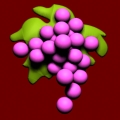Brief descriptions of some of the RED and WHITE grape varieties, and wine producing REGIONS.
A
AIRÉN,
B
BARBERA,
BARDOLINO,
BEAUJOLAIS,
BORDEAUX,
BURGUNDY,
C
CABERNET FRANC,
CABERNET SAUVIGNON,
CARIGNAN,
CHABLIS,
CHAMPAGNE,
CHARDONNAY,
CHEMIN BLANC,
CHIANTI,
CORVINA,
G
GAMAY,
GARGANEGA,
GEWÜRZTRAMINER/TRAMINER,
GRENACHE,
M
MERLOT,
MOLINARA,
MUSCAT,
N
NEBBIOLO,
P
PINOT BLANC/PINOT BIANCO,
PINOT NOIR,
R
RIESLING,
RONDINALLA,
RUBY CABERNET,
S
SANGIOVESE,
SAUVIGNON BLANC,
SÉMILLON,
SOAVE,
SYRAH/SHIRAZ,
V
VALPOLICELLA,
Z
ZINFANDEL
RED GRAPE VARIETIES
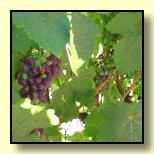 BARBERA
BARBERA
Probably the most widely grown grape in Italy. It makes good, fruity, chewy wines with firm acidity and which need less aging than many other Italian reds. Also grown successfully in California and Australia.
CABERNET FRANC
A slighly lesser grape than its "noble" brother Cabernet Sauvignon, this grape usually makes a lighter wine with less obvious tannin. Grown thoughout Bordeaux, it is used in blends with Cabernet Sauvignon, Merlot and others. However, some of the best Loire wines are pure Cabernet Franc.
CABERNET SAUVIGNON
Often referred to as the "king of red grapes", it is used both on its own and blended with the softer Merlot to make some of the world's best wines. Rich, yet dry, with the smell and flavour of blackcurrents, cedarwood or green peppers. Its thick skins give it the tannic strength for long life.
CARIGNAN
A black grape generally used for table, dessert wines and rosés.
CORVINA
Also known as Corvina Veronese or Cruina. An Italian wine grape mainly grown in the Veneto region of northeast Italy. Corvina is used with several other grapes (such as Rondinella or Molinara) to create the light red Bardolino and Valpolicella wines.
GAMAY
Full name is Gamay Noir à Jus Blanc. A purple-colored grape used to make red wines, most notably in Beaujolais and in the Loire Valley around Tours. Cultivated since the 1400s, and although often frown for its abundant production, it can produce distinctive wines when planted on acidic soils, which soften the grape's high acidity.
GRENACHE
Widely planted in the Rhône. In Spain, it is known as Garnacha, and is one of the Rioja's major grapes. Also grown in California and Australia's Barossa Valley - producing some of that country's best wines.
MERLOT
Merlot wines are buttery, plummy, toffeed and sometimes minty - and almost always soft. On its own, it makes light, juicy wines, but it is widely used as a blend with the tougher Cabernet Sauvignon to make wines of more depth and complexity. Any country growing Merlot will likely grow Cabernet Sauvignon as well. An interesting note - not having it's own root system, Merlot is a product of grafting.
MOLINARA
A red Italian wine grape grown primarily in the Veneto region of north eastern Italy. It adds acidity to Valpolicella and Bardolino blends.
NEBBIOLO
Italy's answer to the Syrah. Traditionally, it has made black, dry, tannic wines. The more modern wine styles are fruitier and benefit from the sweetness of new oak barrels.
PINOT NOIR
Sometimes described as the world's most sulky variety, it has begun to be successful beyond its base in Burgundy. Fine examples of Burgundian Pinot Noir have great delicacy and elegance, with characteristic flavours of wild strawberry, raspberry and occasionally black cherry.
RONDINALLA
A red Italian wine grape grown primarily in the Veneto region of north eastern Italy and used in wines such as the Valpolicella and Bardolino blends.
RUBY CABERNET
A cross between Carignan and Cabernet Sauvignon.
SANGIOVESE (san-jo-vay-zay)
A red Italian wine grape that appears to have originated in Tuscany, where it is the main component of the region's Chianti blend. It has been known since the 16th century, and the name comes from the Latin sanguis Jovis ("the blood of Jove"). Young Sangiovese wine has fresh fruity flavours of strawberry and some spiciness, but it readily takes on oaky, even tarry, flavors when aged in barrels.
SYRAH/SHIRAZ
A deep, sweet, blackberry richness, showing best with age. Traditionally used in France to give color and body to feebler wines, it blends well with Cabernet-Sauvignon. A number of wineries in California, Australia, Chile, Spain and Italy have successfully introduced this grape.
ZINFANDEL
California has a grape to call its own - a black grape that has a distinction of being all things to all people. It makes jug wine, fine wine and "port". One of its main roles is to blend with the Muscat to make simi-sweet "white" and "blush" rose.
WHITE GRAPE VARIETIES
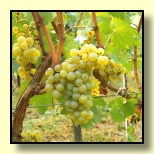 AIRÉN
AIRÉN
If it comes to hectares planted, this is probably the world's number one grape. Grown extensively thoughout Spain, it is usually distilled into brandy and makes an impressive but somewhat flavourless wine.
CHARDONNAY
probably the greatest and most fashionable white wine grape and it is grown thoughout the world. Although it has achieved its best potential in Burgundy, it is thought to have originated in Lebanon. The grape has a natural affinity with oak, which can lend a delicious and toasty comnplexity to the wine. There are good Chardonnays in Spain, South America, South Africa, New Zealand and Australia, and California produces a world class grape.
CHEMIN BLANC
Often considered one of the "trickier" grapes, it is nevertheless widely planted. It ripens late and has high acidity.
GARGANEGA
A white Italian wine grape grown in the Veneto (wine) region of north-east Italy, particularly in the provinces of Verona and Vicenza. Italy's 6th most widely planted white grape forms the basis of Venetian Soave wine and in the blend used to make Gambellara.
GEWÜRZTRAMINER/TRAMINER
With the German word Gewürz, or "spice" added to the varient of the Italian Traminer grape (both names can be applied to the same grape), it is one of the most difficult wines to sell because nobody can pronouce the name. It is however, one of the easiest grapes to recognize because of its perfumed, spicy, exotic fruit smells and flavours, and oily richness.
MUSCAT
This basic grape goes under a wide variety of names and is grown all over the world. The wines the grapes make all have one common characteristic - they actually taste of grapes.
PINOT BLANC/PINOT BIANCO
Aa grape found in almost every wine growing region of the world, usually producing different flavours and textures everywhere it is grown.
RIESLING
Widely mispronounced (the first syllable rhymes with Nice the place - not nice the adjective), it is thought to have originated in Germany's Rhine Valley. The grape is more versatile than the Chardonnay, and it is used to make some of the world's greatest sweet wines, as well as some of the driest. Flavours can combine lime, grape, apple and spice.
SAUVIGNON BLANC
One of the most easily recognized white grapes and one of the most popular. Not known to age well, but one of the best varieties for wine to accompany spicy Eastern or east-meets-west cuisine.
SÉMILLON
A split-personality white grape producing everything from basic dry white to exquisite, comples sweet wines. Often blended with the Sauvignon and Chardonnay grapes.
WINE PRODUCING REGIONS
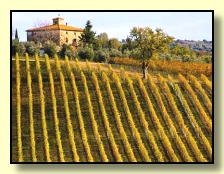 BARDOLINO
BARDOLINO
An Italian red wine produced in the province of Verona, taking its name from the town Bardolino on the shores of Lake Garda. The blend of grapes used to produce the wine includes Corvina, Rondinella and Molinara among others.
BEAUJOLAIS
Wines that take their name from the historical Beaujolais province and wine producing region located north of Lyon, France. While considered part of the Burgundy wine region, the climate is closer to the Rhône and the wine is unique enough to be considered separately from Burgundy and Rhône. The region has a long tradition of winemaking, and more recently known for the popular Beaujolais nouveau.
BORDEAUX
A Bordeaux wine is any wine produced in the Bordeaux region of France, representing about 10,000 producers or châteaux 13,000 grape growers. Most of the wine produced in Bordeaux is red (usually referred to as claret) and quality ranges from everyday table wine to some of the most expensive and prestigious wines in the world. Other wines include sweet white wines, dry whites, rosé and sparkling wines.
BURGUNDY (French: Bourgogne or Vin de Bourgogne)
Wine made in the Burgundy region of eastern France. The most famous "Burgundies" are red wines made from Pinot Noir grapes or white wines made from Chardonnay grapes. Small amounts of rosé and sparkling wine are also produced. Chablis and Beaujolais are included in the Burgundy wine region, but wines from those regions are usually referred to by their own names.
CHABLIS
The northernmost wine producing district of the Burgundy region in France, centered around the town of Chablis. The grapes are almost all Chardonnay, making a dry white wine known for its purity in aroma and taste.
CHAMPAGNE
An area of France famous for sparkling wine produced by inducing in-bottle secondary fermentation of the wine to effect carbonation. Most countries limit the use of the term to only those wines that come from the Champagne region, but some countries maintain a legal right that allows domestic producers of sparkling wine to use the term "Champagne" under specific conditions. Leading manufacturers have sought to create a history and identity for their wine, associating it with high luxury, festivities and rites of passage.
CHIANTI (kee-an-tee)
A famous red wine of Italy, taking its name from the region of Tuscany where it is produced (Italy's highest producing area). Often identified by its squat fiasco ("flask") bottle in a straw basket, most Chianti is now bottled in traditionally shaped bottles.
SOAVE (SWAH-vay)
A dry white wine from the Veneto region in northeast Italy, principally around the city of Verona. Over the centuries the Garganega grape found an ideal habitat in the region, and it is the principal grape of this wine.
VALPOLICELLA
A famous wine producing region in the province of Verona, Italy. Valpolicella ranks only after Chianti in Italian wine production. The red Valpolicella wines are typically light and fragrant, and made from three grape varietals: Corvina Veronese, Rondinella, and Molinara.
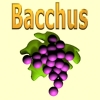 Back to Top
Back to Top


